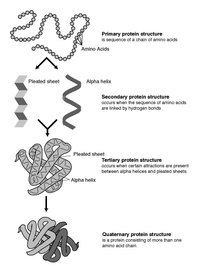
Photo from wikipedia
Dimensionality reduction can be used to project high-dimensional molecular data into a simplified, low-dimensional map. One feature of our recently introduced dimensionality reduction technique EncoderMap, which relies on the combination… Click to show full abstract
Dimensionality reduction can be used to project high-dimensional molecular data into a simplified, low-dimensional map. One feature of our recently introduced dimensionality reduction technique EncoderMap, which relies on the combination of an autoencoder with multidimensional scaling, is its ability to do the reverse. It is able to generate conformations for any selected points in the low-dimensional map. This transfers the simplified, low-dimensional map back into the high-dimensional conformational space. Although the output is again high-dimensional, certain aspects of the simplification are preserved. The generated conformations only mirror the most dominant conformational differences that determine the positions of conformational states in the low-dimensional map. This allows to depict such differences and - in consequence - visualize molecular motions and gives a unique perspective on high-dimensional conformational data. In our previous work protein conformations described in backbone dihedral angle space were used as input for EncoderMap, and conformations were also generated in this space. For large proteins, however, the generation of conformations is inaccurate with this approach due to the local character of backbone dihedral angles. Here, we present an improved variant of EncoderMap which is able to generate large protein conformations that are accurate in short-range and long-range order. This is achieved by differentiable reconstruction of Cartesian coordinates from the generated dihedrals, which allows to add a contribution to the cost function that monitors the accuracy of all pairwise distances between the C α -atoms of the generated conformations. The improved capabilities to generate conformations of large, even multidomain, proteins are demonstrated for two examples: diubiquitin and a part of the Ssa1 Hsp70 yeast chaperone. We show that the improved variant of EncoderMap can nicely visualize motions of protein domains relative to each other but is also able to highlight important conformational changes within the individual domains.
Journal Title: Journal of chemical information and modeling
Year Published: 2019
Link to full text (if available)
Share on Social Media: Sign Up to like & get
recommendations!